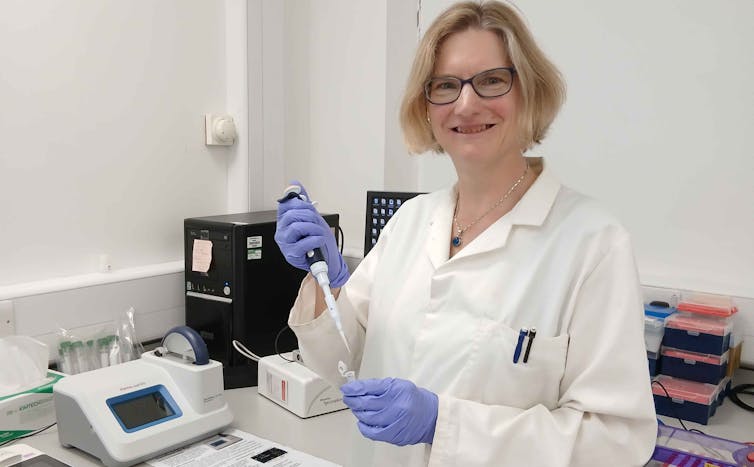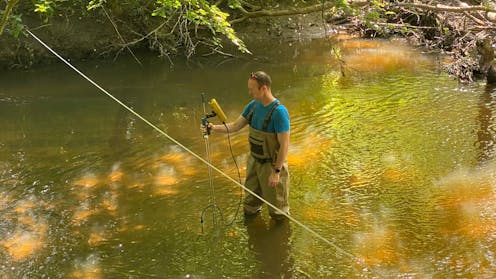Source: The Conversation – UK – By Stefano Kaburu, Senior Lecturer in Conservation Biology, Nottingham Trent University
Drinking more than you intended may be something that many humans do, but now research is showing that a taste for alcohol is surprisingly common among animals. In fact a new study has found that chimpanzees may ingest the equivalent of two alcoholic drinks a day from eating fermented fruit.
In the last ten years or so, there has been growing evidence that the ingestion of alcohol might be more widespread across the animal kingdom than previously thought. Fruit flies, for example, lay their eggs in alcohol-rich fermented fruits, which offer the newly hatched larvae nutrients to feed on.
In 2015, scientists observed groups of chimpanzees in west Africa drinking large amounts of raffia palm alcoholic sap harvested by the local villagers. More recently, in April 2025, a population of chimpanzees at Guinea-Bissau were recorded feasting on ripe African breadfruits which contained high concentrations of alcohol.
The published studies mark a shift because evidence of alcohol consumption in wild animals tends to rely more on anecdotal observations. In Sweden, a moose made the news in 2011 when it was found stuck in a tree, apparently drunk from eating fermented apples.
And vervet monkeys in St Kitts, whose ancestors were brought there with enslaved people from west Africa, are often spotted stealing fruity cocktails from tourists.
The new study, led by biologist Aleksey Maro of the University of California, Berkeley, offers insights into how much alcohol is in the ripe fruits favoured by two wild chimpanzee communities living in eastern and western Africa.
Having spent almost a year studying chimpanzees in the wild myself, I have always been mesmerised by how excited they get when they spot their favourite fruits. Chimpanzees go crazy for fruit. They rush over to grab them and stuff their mouths full, all while making joyful noises of appreciation.
In their research, Maro and his colleagues collected more than 200 fruits from about 20 of chimpanzees’ favourite trees. They found large variation in alcohol content with some having zero or nearly zero alcohol content. But some of the fruits most enjoyed by the chimps, such as figs and plums, tend to have a very high alcohol content.
This suggests that chimps may intentionally select fruits for their high levels of alcohol. Because of the large quantity of fruits chimpanzees can eat every day (up to 4kg), the authors worked out that both female and male chimps consume roughly 14 grams of alcohol per day. This corresponds to a standard US alcoholic drink (UK standard drinks contain eight grams of alcohol).

Michaela Pilch/Shutterstock
But it’s not fair to directly compare these numbers between humans and chimps since the effect of alcohol depends on how big an individual is. Alcohol tends to be less potent in bigger people.
With an average weight of around 40kg, chimps tend to be smaller than humans. So the amount of equivalent alcohol that chimps consume actually corresponds to two American standard drinks per day. It sounds like chimps know how to have a party.
The drunken monkey hypothesis
Twenty-five years ago, Robert Dudley, who is one of the authors of the new study, proposed the “drunken monkey hypothesis”. This suggests that alcohol consumption in humans might have an ancient history. Dudley’s idea is that ingesting alcoholic fruits might have given an evolutionary advantage to animals. The alcoholic content in fruits can, for example, indicate to animals which ones are rich in energy and sugar.
Drinking alcohol can be good for health. Fruit flies, for example, ingest alcohol to kill parasites. Even in humans, studies have shown that low levels of alcohol consumption may reduce the risk of heart disease.
Support for the drunken monkey hypothesis came from research showing that the proteins humans need to break down alcohol in their body was already present in the common ancestor we share with gorillas, chimpanzees and bonobos that lived 10 million years ago.
This was a time when African forests started shrinking, and apes started coming down from the tree, adopting a more land-based lifestyle. It’s possible that these apes gained an advantage in eating ripe fermented fruits that had fallen onto the ground, avoiding the competition with other fruit-eating animals who could eat unripe fruit on trees.
Researchers also think that alcohol might make them more sociable. Chimpanzees in west Africa, for example, were observed in April 2025 eating and drinking fermented fruits together.
However, according to Dudley, in addition to having the same human protein that breaks down alcohol, chimpanzees may drink alcohol in low concentrations due to the high volume of liquid and food they ingest. So their stomach may fill up before alcohol reaches intoxicating levels.
This would explain why, in the 11 months that I spent watching chimps in Tanzania, I didn’t once see them wobbling around the forest, clutching a juicy fruit while laughing uncontrollably.
![]()
Stefano Kaburu does not work for, consult, own shares in or receive funding from any company or organisation that would benefit from this article, and has disclosed no relevant affiliations beyond their academic appointment.
– ref. Chimpanzees ingest more than the equivalent of one alcoholic drink a day – new research – https://theconversation.com/chimpanzees-ingest-more-than-the-equivalent-of-one-alcoholic-drink-a-day-new-research-265644






